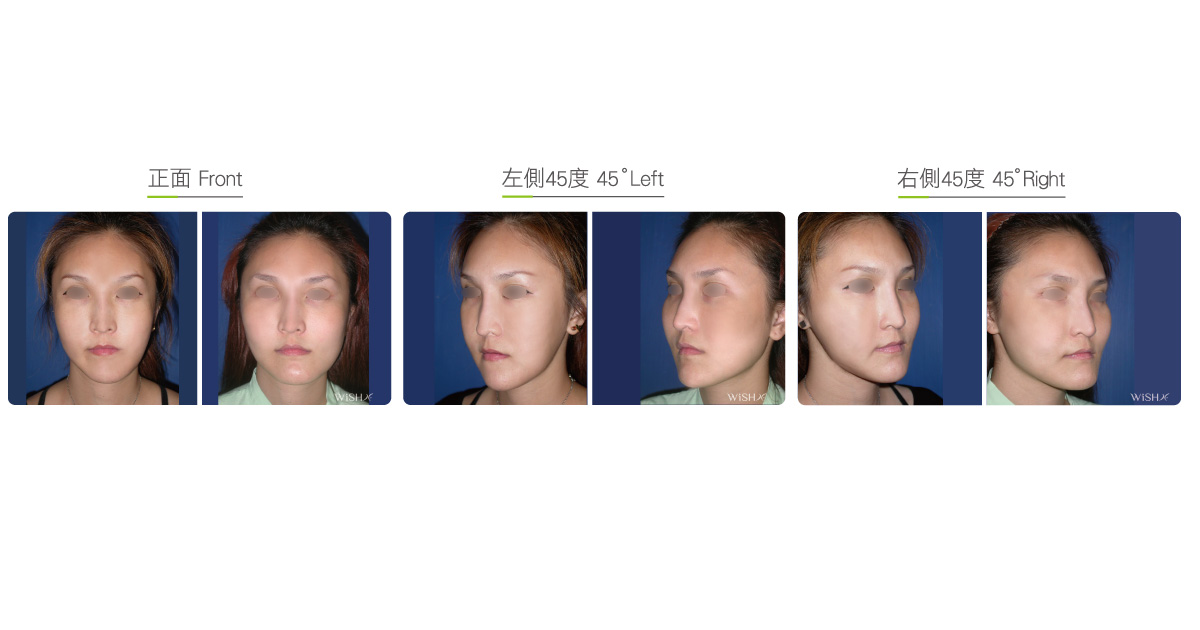Aslant chin correction
An aslant chin appearance is a very common situation in clinics; the most common causes are congenital uneven mandible development (frequently combined with an asymmetric face), trauma, or progressive chin deformation due to teeth extraction (exodontia) or teeth malocclusion. Because an aslant chin is usually noticed in late adolescence, it will not be possible to improve the asymmetric face problem by non-surgical orthodontic treatment, but surgeons will have to consider choosing chinbone cutting as a radical correction in most cases. However, because these patients usually have combined defects of teeth malocclusion, surgeons have to evaluate the expectations of patients and the necessity of extensive prognathic surgery as well. If patients are undergoing orthodontic treatment just before surgery, it is better for them to receive chinbone osteotomy after the dental braces (orthodontic cases) are removed to obtain accurate measurements and expected results.
The surgeries for correcting an aslant chin are very similar to other chinbone osteotomies. Based on the individual bone conditions and slant, the procedures vary, from simple ones such as cortical resection surgery and reduction to more complex ones such as chinbone osteotomy plus unilateral mandible bone reduction. Dr. Chuang always provides several surgical options for patients to choose after evaluating the images of X-rays and 3-D CT scans. During the procedure, Dr. Chuang will make a 5-cm incision in the lower gum; if transverse osteotomy is needed, he will unequally cut off the chinbone or remove some bone segments (segmental resection) after measuring the bone mass difference in both sides and then perform anterior or posterior sliding fixation with steel wires or titanium bone screws and plates. In case of severe skewing, Dr. Chuang will have to extend the bone cutting range backward to one side of the mandible body to perform cortical osteotomy and then adjust the chin in the central position to make the lower face look normal and symmetrical.
Surgical conditions
Duration
- Type of anesthesia: General anesthesia
- Type of incision: Intraoral lower gum (5 cm)
- Recovery: 7–10 days
- Removal of stitches: None
General instructions
No food and water on the day of surgery
- Only a soft or fluid diet should be consumed for 1 week postoperatively.
- Extensive opening of mouth or consumption of very hard food and fruits should be avoided for 1 month postoperatively.
- Force on the face or squeezing of the face should be avoided for 3 months postoperatively.
- A warm towel should be applied on the chin every day to help sensitivity recovery within 6 months postoperatively.
Ideal candidates
- Those with obviously slanted or displaced chins in the front view.
- Those with asymmetric mandibles and chins (unequal face).
- Those with asymmetric mouths due to aslant chinbone development.
Potential complications
- Temporary chin numbness
- Asymmetric mouth shape or expression
Surgical advantages
-
Will simply correct the chin deviation but not affect teeth occlusion.
-
Surgery is relatively simple; recovery is fast.
-
Much lower surgical risk than prognathic surgery.
Surgical drawbacks
-
The lower lip or chin can develop temporary numbness.
-
Unable to improve functional conditions such as teeth malocclusion.
-
The chin can still gradually be displaced if the severe malocclusion is not corrected.

